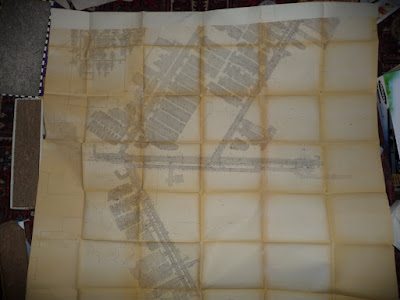Come listen you fellers, so young and and so fine
and seek not your fortune in the dark dreary mine
It will form as a habit, and seep in your soul
'til the stream of your blood runs as black as the coal.
Since I spent all my money traveling to Peru, and working for free for six days a week, I had to find another way to pay tuition, room, and board. Luckily for me, mining was still an expanding field at the time. (Remember, oil prices were pretty high back then. And coal was a substitute for oil, and you know from econ 101 what happens next) So I was able to get a "co-op" job at the Consolidation Coal Company's Hillsboro Mine. (Co-op jobs generally lasted a semester. I took a semester and a summer each time.) So in January of 1997, I moved down to Greenville, IL, and started my work in the mine.
This was an underground mine (since closed down) that was mining Illinois Number 7 (Danville) Coal. This was part of a mine-mouth complex that served an Illinois Power plant. It was located just south of Coffeen, IL:
View Hillsboro Mine in a larger map
It was a good sized, and fairly old mine:
That is a map(looking down) at the mine. We did what was called "Room and Pillar" mining, where you took a bite out of the coal in long entries, and then cross-cuts leaving pillars of coal to hold up the roof:
The pillars were about 50' across, the entries about 16' wide. If I recall correctly we recovered only about 40% of the coal. Other techniques (Longwall mining) recovered much more.
The "continuous miners" were huge machines that chewed up the coal with teeth like this:
The miners themselves looked like this:
We would occasionally use a method called "Pillar Robbing" as we were leaving (retreating from) a section:
YOU can see the "robbed" pillars in the lower portion of this map. You can also see that we couldn't mine under cemeteries. Mineral rights issues.
The mine was about 700' underground. We had two "tipples" one for people, one for coal. This is the Man Tipple:
I spent about half my time underground, half surveying land rights, and half in the office:
We had a small staff, and this was a small town in southern Illinois:
Look at those tools on the wall. French curves, protractors, etc. We used those.
I was living there when Elvis died.
and seek not your fortune in the dark dreary mine
It will form as a habit, and seep in your soul
'til the stream of your blood runs as black as the coal.
-Merle Haggart
 |
| From Illinois |
Since I spent all my money traveling to Peru, and working for free for six days a week, I had to find another way to pay tuition, room, and board. Luckily for me, mining was still an expanding field at the time. (Remember, oil prices were pretty high back then. And coal was a substitute for oil, and you know from econ 101 what happens next) So I was able to get a "co-op" job at the Consolidation Coal Company's Hillsboro Mine. (Co-op jobs generally lasted a semester. I took a semester and a summer each time.) So in January of 1997, I moved down to Greenville, IL, and started my work in the mine.
This was an underground mine (since closed down) that was mining Illinois Number 7 (Danville) Coal. This was part of a mine-mouth complex that served an Illinois Power plant. It was located just south of Coffeen, IL:
View Hillsboro Mine in a larger map
It was a good sized, and fairly old mine:
 |
| From Illinois |
That is a map(looking down) at the mine. We did what was called "Room and Pillar" mining, where you took a bite out of the coal in long entries, and then cross-cuts leaving pillars of coal to hold up the roof:
 |
| From Illinois |
The pillars were about 50' across, the entries about 16' wide. If I recall correctly we recovered only about 40% of the coal. Other techniques (Longwall mining) recovered much more.
The "continuous miners" were huge machines that chewed up the coal with teeth like this:
 |
| From Illinois |
The miners themselves looked like this:
 |
| From Illinois |
We would occasionally use a method called "Pillar Robbing" as we were leaving (retreating from) a section:
 |
| From Illinois |
YOU can see the "robbed" pillars in the lower portion of this map. You can also see that we couldn't mine under cemeteries. Mineral rights issues.
The mine was about 700' underground. We had two "tipples" one for people, one for coal. This is the Man Tipple:
 |
| From Illinois |
I spent about half my time underground, half surveying land rights, and half in the office:
 |
| From Illinois |
We had a small staff, and this was a small town in southern Illinois:
| From Illinois |
Look at those tools on the wall. French curves, protractors, etc. We used those.
I was living there when Elvis died.

No comments:
Post a Comment